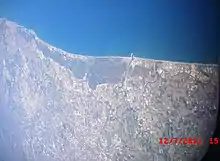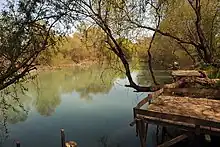Aksu River (Turkey)
The Aksu (Bronze Age name in Hittite: 𒁉𒋻𒀀𒅀, Kaštaraya, ancient name in Greek Κέστρoς, Kestros), is a river in Antalya Province (southwestern Turkey), which rises in the mountains of Toros. The course of the Aksu is between the Düden to the west and of the Köprüçay to the east. It discharges into the Mediterranean near the city of Antalya.[1] The river is about 145 km long and has a total catchment area of 3652 km².[1] There are several lakes in its catchment area, including Lake Kovada and the reservoirs created by the Karacaören-1 and Karacaören-2 Dams.[1]

The Aksu is primarily fed by karstic springs in the Taurus Mountains.[2]: 342 In contrast to the many seasonal streams in the region, the Aksu flows year-round, although its volume can fluctuate dramatically throughout the year.[2]: 342 For example, its flow was measured in 1942 to be 250 m³/s in January and 7.5 m³/s during the summer.[2]: 342 Like other karstic streams, the Aksu does not carry much sediment with it.[2]: 342
In its lower reaches, the Aksu forms a soft, fertile alluvial plain, which contrasts sharply with both the hard travertine complex around Antalya to the west and the rocky Pleistocene terraces to the east.[2]: 342 The Aksu's delta is wave-dominated, due to the river's low sediment load and strong coastal currents.[2]: 342 These processes have turned some former river mouths into closed-off limans and created four distinct systems of dunes running parallel to the coast, reaching heights of up to 12 m.[2]: 342 Some parts of the delta, particularly around river mouths, are swamps which were historically sources of malaria.[2]: 342
Today, the river is impacted by human activities. The Karacaören-1 dam was built to provide water for irrigation, produce electricity, and control flooding downstream.[1] The Karacaören-2 dam was built to provide drinking water for residents of Antalya.[1] The dams siphon off a lot of the Aksu's water to generate electricity, and intensive agriculture in the areas downstream also uses up a lot of the water.[1] As a result, the lower Aksu carries much less water and may even run dry sometimes.[1] The river is also impacted by pollution at several areas: the dam reservoirs are used for domestic and industrial wastewater discharge, and a water treatment plant also discharges into the Aksu.[1]
History

A treaty between the Hittite Great King Tudhaliya IV and his vassal, the king of Tarhuntassa, defined the latter's western border at the "Kastaraya River", near "Parha". Parha is likely the future Perga.[3]
The permanent supply of water, and the resulting fertility of the surrounding plain, was a contributing factor to the prosperity of the ancient city of Perga.[2]: 342
As Kestros, the river is mentioned by Pomponius Mela as navigable, as far upriver as Perga, 60 stadia (about 11.1 kilometres (6.9 mi)) from its mouth, according to Strabo.[4] It silted up over the Byzantine era, and Perga declined as a result.[5]
Today
From the 1854 Dictionary of Greek and Roman Geography, the Aksu is "300 feet (91 m) wide at its mouth, and 15 feet (4.6 m) deep within the bar, which extends across the mouth, and so shallow in places in its delta as to be impassable to boats that draw more than 1 foot (0.30 m) of water".[4] The swell from the sea meeting the stream generally produces a violent surf."[4]
At its headwaters is the Kovada Lake and just below that the Karacaören Dam reservoir.
Fauna
A 2005 study found 17 different species of oligochaeta in various parts of the Aksu and its tributaries: Aulodrilus pluriseta, Aulodrilus pigueti, Potamothrix hammoniensis, Psammoryctides albicola, Tubifex tubifex, Limnodrilus ukedemianus, Chaetogaster diaphanus, Nais pardalis, Nais variabilis, Nais communis, Nais bretscheri, Dero digitata, Aulophorus furcatus, Pristinella osborni, Pristinella jenkinae, and Stylaria lacustris.[6]: 231 Many of these species have a cosmopolitan distribution.[6]: 236
Geology
Around the Aksu River is the Aksu Basin, a sedimentary basin[7] that forms part of the broader Antalya Basin.[8]: 35
In front of the mouth of the Aksu River, there is a broad, shallow marine shelf offshore where the present-day sediments of the Aksu River are deposited.[9]: 142 In the past, this area was deeper; according to Poisson et al, there was likely a canyon, as there still is over by the Düden and Karaman mouths near Antalya, but this canyon has since been filled in by Quaternary deposition from the Aksu River.[9]: 142
Poisson et al reconstructed the course of the Aksu River around the end of the Messinian period (c. 5.3 MYA) this way: the river flowed through the Eskiköy Canyon, then "crossed the Antalya alluvial plain before joining the Antalya abyssal plain, through the actively cutting Antalya canyon".[9]: 135 : 143
During the Quaternary period, the Aksu River cut a new gorge – not in the same place as the Eskiköy canyon; the river's course had changed in the meantime.[9]: 144 During the middle Pleistocene, "deposition in fluvial floodplains and channels along the ancestral Aksu River" created fluvial terraces known as the Belkis Conglomerate.[10]: 10, 17
References
- Tuzan Dugan, S.; Uslu, A.; Orhan, P.; Muhammetoglu, A.; Yesiltas, M.; Kocer, M.A.T.; Muhammetoglu, H. (2022). "Evaluation of Aksu Stream water quality under the influence of anthropogenic pollution and climate change". "Youth" in the Forefront: Before and After World Water Forum. Online Youth Water Congress: "Emerging Water Challenges Since COVID-19": 10–11. Retrieved 1 February 2023.
- Brückner, Helmut; Kelterbaum, Daniel (2019). "The Aksu Çayı (Kestros River) coastal plain and the harbour of Perge". In Kalaitzoglou, Georg; Lüdorf, Gundula (eds.). Petasos: Festschrift für Hans Lohmann (e-book). Brill. pp. 341–53. ISBN 978-3-657-77739-6. Retrieved 1 February 2023.
- G. Beckman (1996). Hittite diplomatic texts. Atlanta.
{{cite book}}: CS1 maint: location missing publisher (link), no. 18C - Smith, William, ed. (1854). "Cestrus". Dictionary of Greek and Roman Geography. London. Retrieved 1 March 2023.
{{cite book}}: CS1 maint: location missing publisher (link) - "Perge".
- Çapraz, Soner; Arslan, Naime (2005). "The Oligochaeta (Annelida) Fauna of Aksu Stream (Antalya)". Turkish Journal of Zoology. 29: 229–36. Retrieved 15 February 2023.
- Wasoo, Muhammad Harbi; Özkaptan, Murat; Koç, Ayten (October 2020). "New insights on the Neogene tectonic evolution of the Aksu Basin (SE Turkey) from the Anisotropy of Magnetic Susceptibility (AMS) and paleostress data". Journal of Structural Geology. 139: 104137. Bibcode:2020JSG...13904137W. doi:10.1016/j.jsg.2020.104137. S2CID 225021825. Retrieved 15 February 2023.
- Üner, Serkan; Özsayın, Erman; Dirik, Kadir; Ciner, Attila (January 2018). "Reconstructing the sedimentary evolution of the Miocene Aksu Basin based on fan delta development (eastern Mediterranean-Turkey)". Turkish Journal of Earth Sciences. 27 (1): 32–48. doi:10.3906/yer-1705-21. Retrieved 13 February 2023.
- Poisson, André; Orszag-Sperber, Fabienne; Kosun, Erdal; Bassetti, Maria-Angella; Müller, Carla; Wernli, Roland; Rouchy, Jean-Marie (May 2011). "The Late Cenozoic evolution of the Aksu basin (Isparta Angle; SW Turkey). New insights". Bulletin de la Société Géologique de France. 182 (2): 133–48. doi:10.2113/gssgfbull.182.2.133. Retrieved 10 February 2023.
- Kaya, Ersin (2014). Structure and Tectonics of the Late Cenozoic Transtensional Aksu Sedimentary Basin, SW Anatolia. Retrieved 12 February 2023.
- Glover, Clare P, Robertson, Alastair F (March 1998) "Role of regional extension and uplift in the Plio-Pleistocene evolution of the Aksu Basin, SW Turkey" Journal of the Geological Society 155(2): pp. 365-387 Archived 2008-01-02 at the Wayback Machine
- Wildekamp, R.H. (1997) "First record of the eastern Asiatic gobionid fish Pseudorasbora parva from the Asiatic part of Turkey" Journal of Fish Biology 51(4): pp. 858–861